This article was published in Scientific American’s former blog network and reflects the views of the author, not necessarily those of Scientific American
It’s very frequently said that fossils provide the basis for our understanding of evolution by way of natural selection. At other times it’s said that our discovery of DNA and the molecular world provides the basis for our understanding of evolution by way of natural selection. These statements are not necessarily incorrect, but what’s sometimes missed is the significance of domestic animals to our understanding of evolution by way of natural selection. Domestic animals – the pigeons, chickens, dogs, rodents, horses, cattle, pigs, sheep and so on and on that figure somewhere in our lives – have been hugely important as goes the very development of ideas on evolution and the demonstration of its reality, even though their evolution has been ‘unnaturally’ selected.
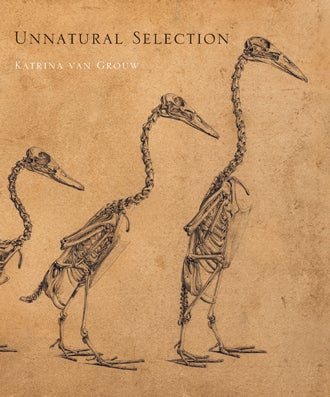
Front cover of Unnatural Selection, featuring some very special ducks (on which, see below). Credit: Princeton University Press
Despite the scientific significance of domestic animals, it must be said that there remains a sort of ‘domestic animal snobbery’ in which human-made creatures have been insufficiently documented in the literature, somewhat under-studied by biologists, and neglected or ignored by those building or maintaining zoological collections. None of which seems appropriate. A few good books do provide overviews of domestic animals, most notably Zeuner’s A History of Domesticated Animals (Zeuner 1964) and Clutton-Brock’s wholly mammal-themed Domesticated Animals From Early Times (Clutton-Brock 1981). But the question remains: when will domestic animals get their due?
On supporting science journalism
If you're enjoying this article, consider supporting our award-winning journalism by subscribing. By purchasing a subscription you are helping to ensure the future of impactful stories about the discoveries and ideas shaping our world today.
Well, now is the time. Regular readers will be familiar with the much-loved, beautiful and widely acclaimed The Unfeathered Bird of 2013 (previously discussed here at Tet Zoo), written and illustrated by Katrina van Grouw. As hinted at in that work (van Grouw 2013) – and in some articles about it – one apparently unforeseen spinoff from The Unfeathered Bird was a previously undeveloped appreciation of domestic animals, their anatomy and variation, the stories behind them, and their significance for our understanding of evolution. And it is particular aspects of biology that Katrina focuses on in her new work – unpublished at the time of writing – Unnatural Selection.
The theme of, and expertise expressed within, The Unfeathered Bird has of course made many of us think of Katrina as a ‘bird anatomy person’. Unnatural Selection does include a lot of material on birds, but it also includes substantial information on a great many other animals too, mammals getting equal or greater coverage. Fishes and insects feature in the work as well. And while The Unfeathered Bird features scores of anatomical illustrations (depicting bones and muscles and so on), Unnatural Selection includes numerous wonderful depictions of live animals in addition to its anatomical illustrations.
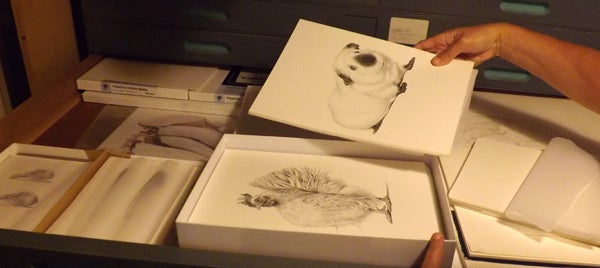
Hundreds of new illustrations produced for this project: here are a number of originals, kindly shown to me by Katrina van Grouw. Credit: Darren Naish
As goes overall design, I haven’t yet seen a copy of the finished product but I understand that it’s similar in format and size to The Unfeathered Bird, albeit with more text and more illustrations. Those who enjoy Katrina’s works will also be pleased to hear that the annotations adjacent to her illustrations have been penned by the uniquely skilled Natee Himmapaan.
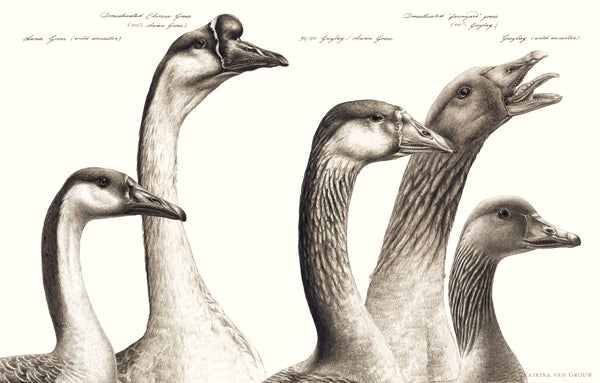
Geese (wild and domesticate) from Unnatural Selection. This panel combines Katrina’s illustrations with Natee Himmapaan’s amazing skills in writing and labelling. Credit: Katrina van Grouw
The influence humans have had on those animal species we’ve shaped through selective breeding is enormous. As is well known, there are an insane number of absurd, ‘extreme’ domestic animal breeds: highly modified ducks that walk with a bolt-upright stance, cats with shortened ‘munchkin’ legs, hairless dogs and cats and mice, pigs and cows with ‘mule-feet’, chickens with tail feathers many metres long, ‘double-muscled’ cows and dogs, and the incredible, disturbing Gibber Italicus.
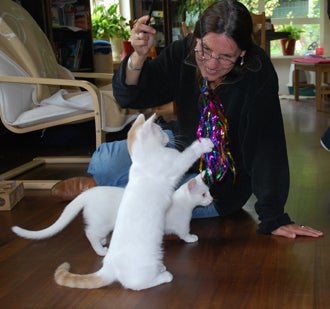
During research for the book, Katrina visited all manner of domestic animals. Here she is with two munchkins. Credit: Katrina van Grouw
Showcasing weirdos is all well and good – and easy enough to do given that there are so many of them. But rather than take us on a tour of domesticated species or groups of species (something that could easily expand into some gargantuan, eternal task… and be considered both a difficult sell and a tedious read), Unnatural Selection is structured around the main themes of domestication: the plasticity that we have bred into domestic animals, the history of domestication and the relevant changes themselves, and the patterns we observe in domestic animals across the generations (some of which have ramifications for the genetics and environmental influences underlying expression, a la Mendel’s peas). In short, we’re seeing a celebration of the processes and mechanisms of evolution. What we see in domestic animals is, as noted above, human-driven evolution, but (1) it’s still evolution and (2) it’s reflective of the variation inherent to the organisms concerned and how it can be guided or expressed.
Given the enormity and complexity of these issues it would follow that a grand review of existing knowledge would be pretty useful. Obviously, there’s a pretty hefty primary literature out there. However, Katrina has gone so much further than this.
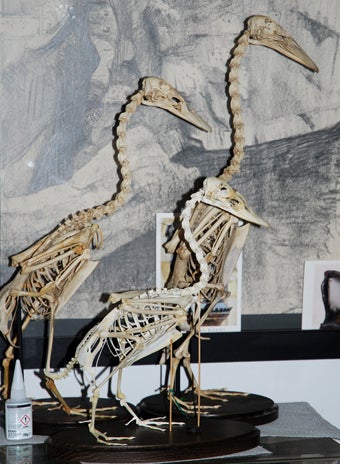
Remember those ducks skeletons depicted on the cover? (yes, it’s a sort-of-parody of so many depictions of primate evolution). Here are the skeletons used as models, in the van Grouw collection. Assembled by Hein van Grouw, ethically sourced, and illustrated by Katrina. Credit: Katrina van Grouw
For starters, she’s gone to extraordinary trouble to obtain a huge amount of first-hand information from museums and other collections, breeders, keepers, taxidermists and other people in the domestic animal world, and has visited a similarly extraordinary number of farms, smallholdings, pigeon lofts, bird rooms and other places where often rare and obscure domestic animals can be observed. I feel pangs of jealousy on reading the long list of places that Katrina visited during her research.
There’s more. Working together with her husband Hein (a “domestic animal nerd”, to use Katrina’s term, and a highly experienced and inventive pigeon breeder to boot), Katrina has embarked on some several-years-long projects of breeding and cross-breeding chickens and pigeons, the various offspring providing insight into the expression of various features and the effects of temperature and environment on phenotype. You will of course be reminded of Darwin’s projects on pigeons. Katrina also (last time I visited) keeps a truly remarkable domestic duck that has (or, rather, had) a most bizarre set of anatomical features.
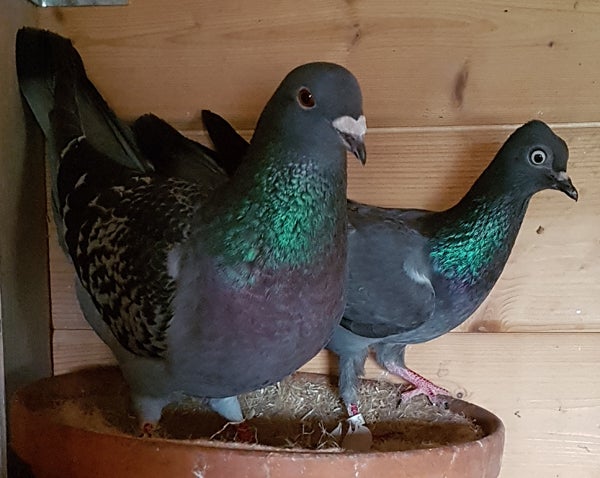
Breeding pigeons in the Hein van Grouw collection. That remarkable bird at the back is a Vienna long-faced tumbler and the one at the front is a racing homer. Credit: Darren Naish
Now, you might think that anyone writing a book on domestic animals need only look to other books when researching a given issue. In fact, there are a huge number of questions where little if anything has been written down. The inclusion of content that comes from novel experimental research (ethical and non-laboratory-based research, I should add) in Unnatural Selection makes this book all the more exciting; there is so much that’s new and very much inspirational as goes possibilities for future research.
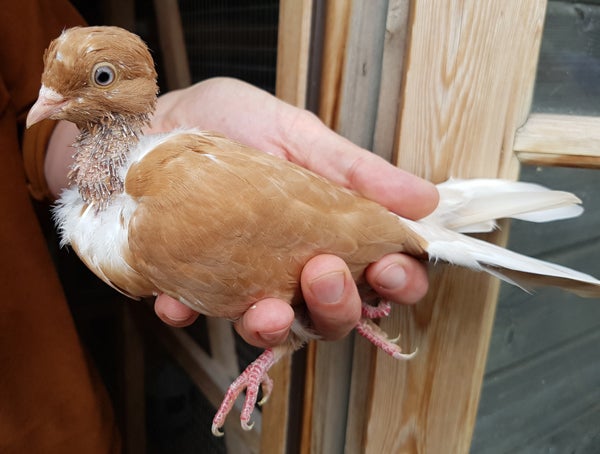
Another remarkable domestic pigeon from the Hein van Grouw collection: this is a Romanian naked-neck tumbler, a breed that originated in the 1890s but did see export to the rest of Europe until the 1960s. That neck isn’t due to moulting, or bad condition, or disease: it’s the normal condition for this breed. It is coincidental that naked-neck chickens come from the same part of the world. Credit: Darren Naish
So… try and imagine all of this first-hand observation, analysis and experimentation combined, mix it with reviews of domestic animal history and with a huge number of amazingly compelling illustrations. What might we learn, as readers?
Well, there’s too much to summarise; we’ll just have to wait for the book. But here are some thoughts. One thing I’ve come to appreciate from talking about domestic animals with Katrina is the ‘mix and match’ nature of the relevant traits. We tend to imagine domestic breeds as distinct branches on a phylogeny, their weird features being apomorphies of the branch. In fact, those features can be moved around to virtually any breed if hybridisation occurs: if, say, you have excessively woolly sheep in one part of the family tree, and especially long-horned sheep in another, there’s no reason why you can’t create a new, excessively woolly, especially long-horned sheep... which then gets called a ‘breed’ too. The term breed doesn’t, therefore, really mean that much: we’re talking instead about small populations that exhibit a specific, constrained amount of the variation inherent to the animals concerned. Breeds aren’t species, in other words. I know this is obvious, but it isn’t stated enough.
A trend present in many domestic breeds – dogs and chickens in particular – is that their removal from ‘functional’ or ‘working’ life (read: ‘fighting’ life in some cases) has resulted in a transition to a role in ‘show’ only. This change has inevitably resulted in a modification of form. The infamous and oft-lamented change of the brachycephalic English or British bulldog, for example, is a result of runaway selection for ever-showier dogs, a role that the dogs must have been maintained for were they (the dogs) to persist. After all, they had no other role following the introduction of the Cruelty to Animals Act of 1835 and the cessation of bull-baiting. Similar patterns shaped chickens and geese after their dedicated role in fighting was made illegal.
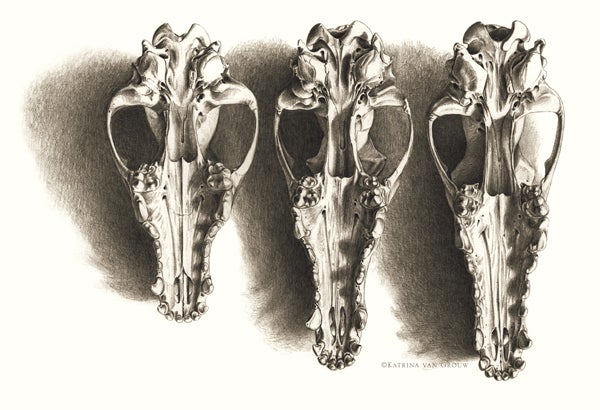
It’s well known that dog breeds have changed a phenomenal amount over the decades (yes: decades, not necessarily centuries). The same is true of so many other domestic animals as well. This illustration shows how collie skulls were much modified via the introduction of borzoi genes. Credit: Katrina van Grouw
And this brings us to an important point. There’s a popular idea that people interested in maintaining a given domestic animal breed have deliberately bred for maladaptive traits that create the various health problems we’re so familiar with. But this is uncharitable and ignores the fact that breeders – working hard to maintain the persistence of the breeds in question, especially across and beyond World War II – were essentially forced to encourage inbreeding and thus head the breeds in a given direction when numbers were low. Remember here that we’re typically talking about events that have occurred over several decades, not centuries or millennia.
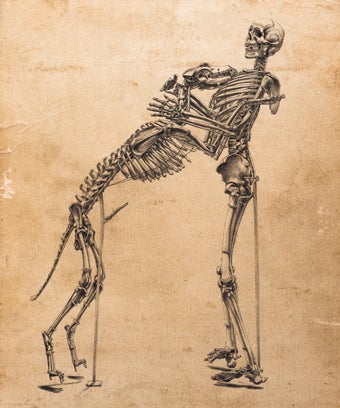
If you remember (or if you’ve read) the Unfeathered Bird article that appeared here back in 2014, you might remember the photos of Grover Krantz and his wolfhound Clyde. Well, Katrina has illustrated their skeletons. Credit: Katrina van Grouw
The fact that domestic animals express novel anatomical configurations not present in their wild cousins is a non-trivial point linked both to the variation that’s possible (yet virtually never expressed in those wild forms) and the speed with which it can be selected for. And the sheer success of domestic animals – the numbers of them that exist, that now dominate sections of the world previously occupied by their wild cousins and ancestors – is proof that domestication was hardly a bad move, in evolutionary terms… in the short-term, at least. So, domestication and the changes it has involved is hardly a non-remarkable thing. It is my contention – and Katrina’s too, I’m sure – that the story of domestication is very much part of the ‘story of animals’ as relevant as any section of history non-contingent on humans.
As I said above, this article is essentially a pre-emptive bit of research on the background to the book, and I’ll surely be writing about it again once it’s out and I have a copy in my possession. I look forward to that day: it will, the publishers tell me, be in late July 2018. This is also a good time to say that Katrina will be selling and signing copies, and talking about the book, at TetZooCon 2018: an event we’re planning right now but have not yet finalised. More news soon.

Coming soon, and appearing on sale at TetZooCon 2018.... Unnatural Selection. Credit: Princeton University Press
Unnatural Selection can be pre-ordered from Princeton here, from amazon here, and from amazon.co.uk here. It’ll be $45 or £35.
For previous articles on domestic animals and other issues relevant to things discussed here, see...
Refs - -
Zeuner, F. E. 1964. A History of Domesticated Animals. Hutchinson of London, London.
van Grouw, K. 2013. The Unfeathered Bird. Princeton University Press, Princeton and Oxford.